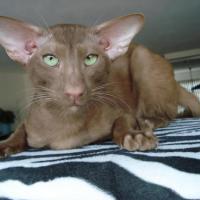Color Across Species part 3: TYRP1
TYRP1 (tyrosinase related protein 1): As pigment develops, it follows a “pathway”. Think of it as a road or highway. If mutations occur early along this highway then they will affect both black and red pigment. (MLPH, discussed in Color Across Species part 2, can be thought of as a truck carrying pigment along the highway.) There is however a point when the development of black and red pigment is separated, a bit like a fork in the road. After this point mutations should only affect red or black pigment but not both. TYRP1 is located “after the fork” and known mutations in TYRP1 only affect black pigment.1 These mutations modify pigment such that normally black pigment (eumelanin) is instead brown or tan. These mutations appear to affect hair, eyes, and skin. This means that in a black and tan dog who is homozygous for TYRP1 gene mutations normally black areas, including the skin, are instead brown. This results in brown skin and lightened eyes. The areas of red pigment (tan areas) remain unchanged. Most of the mutations in TYRP1 are recessive. However, white based brown in mice is inherited as a dominant 2 and brown in native Chinese swine is inherited as an incomplete dominant. 3 It also appears that TYRP1 mutations can be influenced by mutations in other genes, specifically OCA2 (also called P), causing compound phenotypes.4
TYRP1 mutations occur in a variety of species including humans, pigs, mice, dogs, cattle, rats and cats. These mutation result similar but not identical phenotypes. In humans mutations in TYRP1 generally result in reddish or reddish-blond hair. In the solomon Islands a TYRP1 mutation has been found that results in blond hair in otherwise dark colored individuals.5 Mutations in TYRP1 also result in certain forms of albinism know as Oculocutaneous albinism type 3 (OCA3). These forms of albinism result in a lightening of the skin, eyes, and hair rather than the complete absence of pigment and can be found in many of the worlds populations including African, German, Chinese, and Pakistani.6 In dogs, pigs, rats, and cats mutations in TYRP1 result in phenotypes commonly called “brown”. In dogs three separate mutations in TYRP1 result in basically the same phenotype and any two of the three brown mutations will result in a brown dog.7 In cats, two mutations result in similar but somewhat different phenotypes.8 These are brown (or chocolate) and cinnamon. Brown is a darker coat color very similar to brown in dogs while cinnamon is recessive to brown and results in noticeably lighter hair and pinkish skin. A mutation in Chinese swine has been found to result in a phenotype remarkably similar to cinnamon in cats including pink skin when homozygous. 3, 8 Dun in dexter cattle has also been found to be the result of a recessive TYRP1 mutation. To date no mutations in TYRP1 have been found in horses and although some phenotypes have been dubbed “light black” none have shown a reliable genetic inheritance pattern or dilution of skin, therefore, a TYRP1 mutation is unlikely. A brown phenotype is however also found in rabbits and although TYRP1 has not been investigated it could be a candidate gene for this coloration because brown in rabbits is inherited as a recessive and causes a dilution of both skin and hair.
1. Berryere, T. G., Schmutz, S. M., Schimpf, R. J., Cowan, C. M., & Potter, J. (2003). TYRP1 is associated with dun coat colour in Dexter cattle or how now brown cow? Animal genetics, 34(3), 169–75. Retrieved from http://www.ncbi.nlm.nih.gov/pubmed/12755816
2. Javerzat, S., & Jackson, I. J. (1998). White-based brown (Tyrp1B-w) is a dominant mutation causing reduced hair pigmentation owing to a chromosomal inversion. Mammalian genome : official journal of the International Mammalian Genome Society, 9(6), 469–71. Retrieved from http://www.ncbi.nlm.nih.gov/pubmed/9585436
3. Ren, J., Mao, H., Zhang, Z., Xiao, S., Ding, N., & Huang, L. (2011). A 6-bp deletion in the TYRP1 gene causes the brown colouration phenotype in Chinese indigenous pigs. Heredity, 106(5), 862–8. doi:10.1038/hdy.2010.129
4. Manga, P., Kromberg, J. G., Box, N. F., Sturm, R. a, Jenkins, T., & Ramsay, M. (1997). Rufous oculocutaneous albinism in southern African Blacks is caused by mutations in the TYRP1 gene. American journal of human genetics, 61(5), 1095–01.doi:10.1086/301603
5. Sindya N. Bhanoo (3 May 2012). "Another Genetic Quirk of the Solomon Islands: Blond Hair". The New York T
6. Zhang, Kai-hui, Zhuo Li, Jie Lei, Ting Pang, Bei Xu, Wei-ying Jiang, and Hong-yi Li. "Oculocutaneous Albinism Type 3 (OCA3): Analysis of Two Novel Mutations in TYRP1 Gene in Two Chinese Patients." Cell Biochemistry and Biophysics 61.3 (2011): 523-29. Springer. Humana Press Inc. Web.imes. Retrieved 3 May 2012.
7. Schmutz, S. M., Berryere, T. G., & Goldfinch, A. D. (2002). TYRP1 and MC1R genotypes and their effects on coat color in dogs. Mammalian genome : official journal of the International Mammalian Genome Society, 13(7), 380–7. doi:10.1007/s00335-001-2147-2
8. Schmidt-Küntzel, a, Eizirik, E., O’Brien, S. J., & Menotti-Raymond, M. (2005). Tyrosinase and tyrosinase related protein 1 alleles specify domestic cat coat color phenotypes of the albino and brown loci. The Journal of heredity, 96(4), 289–301. doi:10.1093/jhered/esi066


